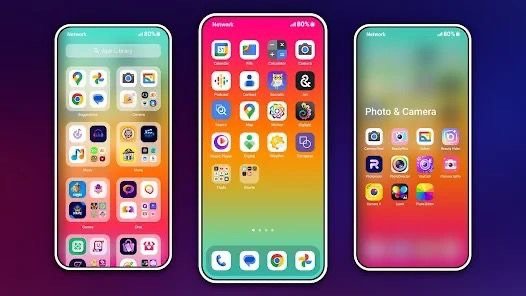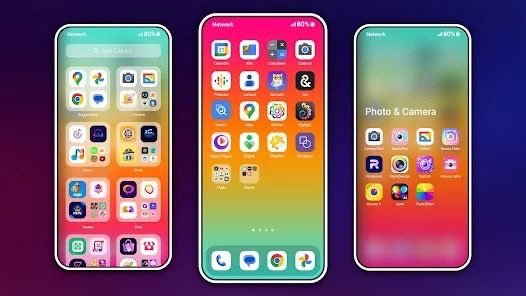The iPhone Look and Feel on Your Android: A Deep Dive into iPhone Launchers
Introduction:
Have you ever admired the sleek, minimalist interface of an iPhone, with its iconic app grid and smooth animations, and wished you could have that on your Android device? You’re not alone. While Android is celebrated for its customization, many users are drawn to the simplicity and polished design of iOS. The good news is, you don’t have to switch phones to get the iPhone experience. Thanks to a thriving community of developers, there are “iPhone launchers” for Android that can transform your device’s home screen, app drawer, and even system-level features to mimic iOS. This article will provide a comprehensive, humanized look at what these launchers are, how they work, and what to expect when you dive into this fascinating world of digital mimicry.

What is an Android Launcher?
Before we get into the specifics of iPhone launchers, let’s understand the core concept. In simple terms, an Android launcher is an app that dictates your phone’s user interface. It’s the “home” screen you see when you unlock your phone. It manages how your apps are displayed, how you navigate between screens, and often includes features like gestures, a search bar, and customization options. Think of it as a skin that sits on top of the Android operating system, allowing you to completely change the look and feel of your phone without altering the underlying OS.
The Appeal of an iPhone Launcher on Android:
So, why would an Android user want an iPhone launcher? It’s not just about aesthetics. The appeal lies in a combination of factors:
- Aesthetics and Simplicity: iOS is renowned for its clean, uncluttered design. The iconic grid of app icons, with no app drawer, provides a streamlined experience. For users who find the endless customization of Android overwhelming, an iPhone launcher offers a refreshing sense of simplicity.
- Familiarity for Switchers: Many people switch from an iPhone to an Android device. The new interface can be a bit jarring. An iPhone launcher can make the transition smoother by providing a familiar layout, reducing the learning curve.
- Performance and Fluidity: While Android has made significant strides in performance, some users still perceive iOS as being “smoother.” Many iPhone launchers are designed to mimic the fluid animations and scrolling of iOS, giving a sense of snappiness to the user experience.
- Curiosity and Fun: Let’s be honest, it’s also a bit of a novelty. It’s fun to see how well an Android can emulate its rival’s operating system. It’s a testament to Android’s flexibility and an interesting experiment in digital design.
How iPhone Launchers Work Their Magic:
An iPhone launcher for Android is more than just a wallpaper change. These apps work by replicating key elements of the iOS interface. Here’s a breakdown of the typical features you can expect: - The Home Screen and App Grid: This is the most noticeable change. The launcher replaces your standard Android home screen with the classic iOS app grid. All your installed apps appear on the home screen, without a separate app drawer. You can organize them into folders, just like on an iPhone.
- The Control Center: One of the most beloved features of iOS is the Control Center, a quick-access panel for toggles like Wi-Fi, Bluetooth, screen brightness, and flashlight. Many iPhone launchers include a swipe-up or swipe-down gesture from the bottom or top of the screen to bring up a near-identical Control Center.
- The Notification Center: Swiping down from the top of the screen on an iPhone reveals the Notification Center, which combines notifications and widgets. A good iPhone launcher will replicate this, sometimes with a dedicated screen for notifications and a “Today” view for widgets.
- The “Today” View and Widgets: The “Today” view, which lives to the left of your first home screen, is where you find widgets for news, weather, and other apps. Many launchers offer a similar screen, allowing you to add widgets in a way that mimics the iOS layout.
- Icon Packs and Aesthetics: The developers of these launchers often include custom-designed icon packs that match the rounded, glossy look of iOS app icons. This attention to detail is crucial for creating an authentic experience.
- Search Functionality: The ability to swipe down anywhere on the home screen to access a system-wide search is a hallmark of iOS. Launchers replicate this feature, allowing you to quickly find apps, contacts, and information.
- Gestures and Animations: This is where the magic truly happens. A high-quality iPhone launcher will include fluid animations for opening and closing apps, swiping between screens, and accessing the Control Center. These subtle touches make the experience feel smooth and responsive.
Things to Consider Before Installing:
While iPhone launchers offer a fantastic way to customize your phone, there are a few things to keep in mind: - Performance Impact: Launchers run as an app in the background. While many are optimized for performance, some can consume more battery or RAM than the stock Android launcher. This is especially true for older or less powerful devices.
- Ad-Supported and Pro Versions: Many popular launchers are free but ad-supported. This means you might see occasional ads in the settings or during a feature’s first use. There are often “Pro” or “Premium” versions available for a one-time fee to remove ads and unlock additional features.
- Not a Full OS Conversion: It’s important to remember that this is a “skin,” not a full operating system conversion. You will still have the Android settings menu, app permissions, and underlying system features. The launcher can’t change how your camera app works or add iMessage.
- App Integration Limitations: Some deep-seated Android features, like a dedicated app drawer or certain widgets, might not be fully supported by the launcher. The goal is to mimic iOS, so it may omit some features that are standard on Android.
- Conclusion:
iPhone launchers for Android are a fantastic example of the open-source spirit and flexibility of the Android ecosystem. They offer a unique way to experience a different design philosophy without changing your hardware. Whether you’re a curious Android user, a recent iPhone switcher, or simply someone who appreciates clean design, these launchers provide a surprisingly complete and satisfying transformation. They show that you don’t have to choose between the power and customization of Android and the simplicity and elegance of iOS—you can have the best of both worlds, right in the palm of your hand. So go ahead, download one, and see if the grass truly is greener on the other side of the digital fence.
